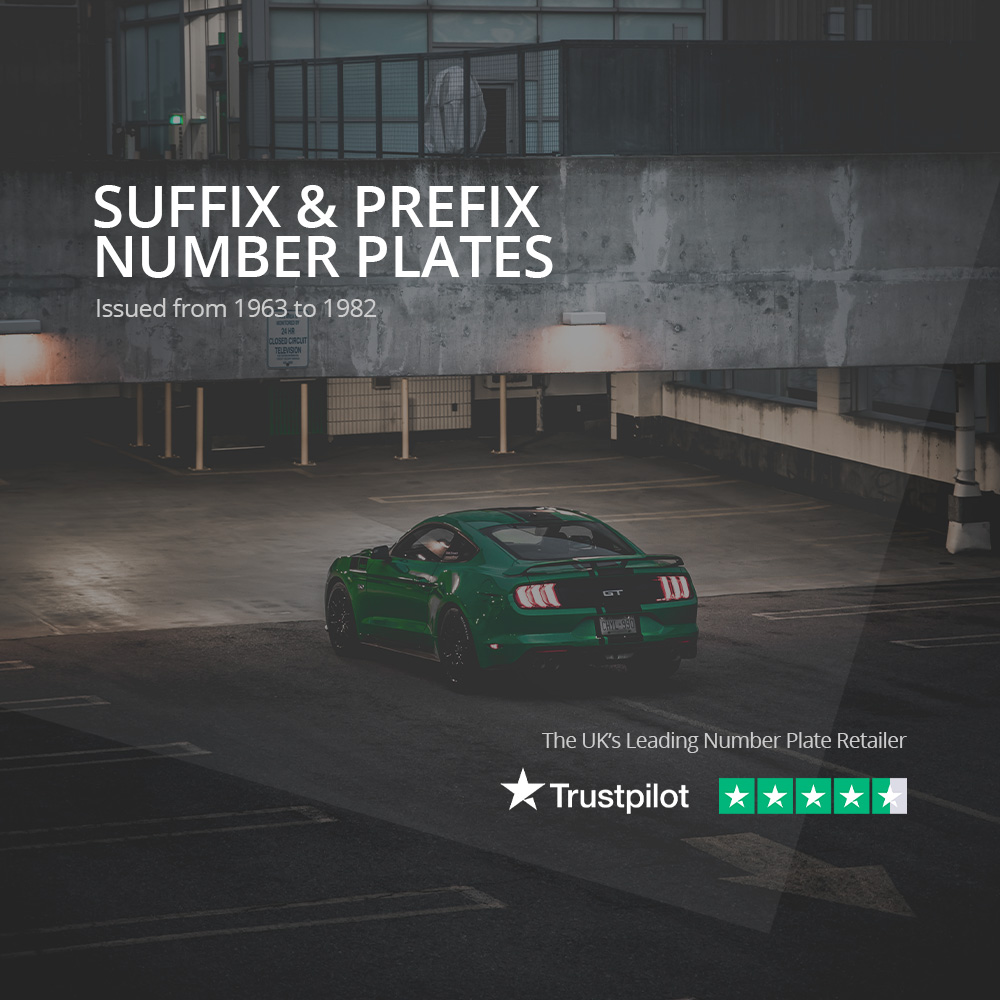With dateless registrations coming to an end in 1963, a new type of registration had to be launched to replace them. Suffix style registrations filled this space initially, with prefix style being added into the mix two decades later when suffix plates could no longer be issued to new vehicles.
Beginning with the letter ‘A’ in 1963, all the way until ‘Y’ in 1982, the contact increase in yearly vehicle sales was matched by the vast amount of different suffix plate combinations a vehicle could have assigned to it.
For example, plates the were issued in 1963 could be something like “ABC 23A” or “GHZ 1A” and a suffix reg issues in 1966 could be “JJL 999D” or “PAA 84D”.


What are suffix registrations?
Suffix registration plates are vehicle identifiers which allow you to identify the age of a vehicle based on the letter which comes at the end of it. Starting with the letter A in 1963 until Y in 1982, suffix plates typically contained three letters followed by three numbers and a final age identifying letter. However, it was also possible for suffix registration numbers to have three letters followed by one or two letters which preceded the age identifier too.
The first three letters are not randomly assigned. The second and third letters are the regional identifier for the plate, much like current style plates also have regional identifiers. Meanwhile, the three numbers in the second part of a suffix plate are its unique identifier, and although some believe the assignment to be random, it’s highly likely that they were distributed in sequential order.
Examples of suffix style plates could be ABC 123X, XYZ 9K or even BMT 216A, the plate found on James Bond’s famous Aston Martin DB5.
The biannual release of new registrations can also be explained by the ‘suffix era’, as retailers began to realise that they were receiving a lower number of orders towards the end of the year. Not only was this because of the festivities at the end of the year, meaning people would spend elsewhere, but also if they were looking for a new vehicle, they would wait until the new age identifier was released on 1st January of the following year. In 1967, the release date was moved to 31st August in order to see whether this had an impact on sales. In 1999, the biannual release of new registrations was introduced as a way to keep vehicle sales lifted throughout the year as the latest regs would never be older than 6 months.
- Why are some letters not used in suffix and prefix registrations?
You may have noticed that certain letters do not appear as age identifiers in suffix and prefix registrations. These letters are I, O, U, Q and Z, and there is a perfect explanation as to why each of these aren’t used. I and Z were reserved for cars registered in Northern Ireland, with the letter O completely indistinguishable from a 0. Likewise, it was decided that U looked too similar to V, and Q reg vehicles were only used in special circumstances, usually where the year of manufacture is unknown.
- What year are suffix registrations?
Suffix number plates are typically associated with vehicles released between 1963 and 1982. Looking for a specific suffix registration date? Check our helpful table below!
| Letter |
Year |
| A |
1963 |
| B |
1964 |
| C |
1965 |
| D |
1966 |
| E |
1967 |
| F |
1967 |
| G |
1968 |
| H |
1969 |
| J |
1970 |
| K |
1971 |
| L |
1972 |
| M |
1973 |
| N |
1974 |
| P |
1975 |
| R |
1976 |
| S |
1977 |
| T |
1978 |
| V |
1979 |
| W |
1980 |
| X |
1981 |
| Y |
1982 |
- What are prefix registrations?
Prefix registrations, as the name may suggest, are the opposite of suffix number plates, with the age identifier appearing at the beginning of the registration instead of at the end. Prefix registrations were first introduced in 1983 following the expiry of the suffix style, and was used until 2001, when it was eventually superseded by the current style.
In 1999, the DVLA introduced the biannual release of new registrations, which meant that certain age identifiers did not see a full year before being replaced. ‘S’ Registrations are a prime example of this, which were quickly followed by ‘T’ registrations, which then ran from then until the following August. The same pattern was repeated until the ‘Y’ reg was exhausted in 2001. This was due to the ever increasing pressure and demand for new vehicles as time went on. Now, prefix registrations are no longer issued to new vehicles, you can now buy prefix private number plates for your car!
- What do prefix number plates look like?
As mentioned above, a prefix style number plate is a reverse of the suffix style. They see an age identifier number appear as the first character, which is typically then followed by three numbers, and then three letters. However, it is also possible to have prefix style registrations which contain a letter followed by just one or two numbers. For example, you could have X1 ABC, X11 ABC or X111 ABC and all would be prefix registration plates.
Over the course of the prefix era, the DVLA realised that they could make a considerable amount of money from the sale of private registrations, which meant they deliberately held back certain prefix plates from being assigned to new vehicles. For example, prefix reg’s from A to H and containing numbers 1-20 were some of the registrations held back by the DVLA. When the J registration was released in 1991, the same numbers were held back, as well as other attractive numbers such as 22, 33, 111 and 222. These were later sold as private registrations.
Naturally, some prefix and suffix style registrations clearly depicted names and words which were also held back and sold as private registrations. These were typically sold via auctions, as the DVLA believed this to be the best way to ensure maximum revenue for them. With this, the private number plate industry was born.
Over the years, this also led to some incredible sums of money being exchanged for the most attractive plates. For example, K1 NGS was sold in 1993 for around £230,000, but is now valued at more than double that. Likewise, some of the most attractive number plates plates which read P1 LOT and S1 NGH have also been sold for more than six figures. This perfectly illustrates why prefix and suffix private plates are an investment for the future!
- What year are prefix registrations?
Prefix number plates are typically associated with vehicles released between 1983 and 2001. Looking for information on prefix registration years? Want to know what year a particular letter is for? This table should make it easier for you!
| Letter |
Year |
| A |
1983 |
| B |
1984 |
| C |
1985 |
| D |
1986 |
| E |
1987 |
| F |
1988 |
| G |
1989 |
| H |
1990 |
| J |
1991 |
| K |
1992 |
| L |
1993 |
| M |
1994 |
| N |
1995 |
| P |
1996 |
| R |
1997 |
| S |
1998 |
| T |
1999 |
| V |
1999 |
| W |
2000 |
| X |
2000 |
| Y |
2001 |




 100% Road Legal
100% Road Legal Express Delivery
Express Delivery


